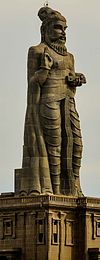Constanzo Beschi
This article includes a list of general references, but it lacks sufficient corresponding inline citations. (January 2008) |
Constantine Joseph Beschi | |
|---|---|
Castiglione delle Stiviere, Duchy of Mantua | |
| Died | 4 February 1747, Kingdom of Cochin, Ambalakkaru, India or Manapad, Tamilnadu, India |
| Resting place | Sampaloor, Kerala or Manapad, Tamilnadu |
| Other names | வீரமாமுனிவர் (Veeramamunivar) |
Constantine Joseph Beschi (8 November 1680 – 4 February 1747), also known under his
Early years
Born in
In South India
Inspired by what was done in China, Beschi adopted the native Tamilians' lifestyle in his life and in his missionary work. For example, he adopted the
During the first six years, he worked as a missionary in
He helped build the
He died at Ambalakaadu in Thrissur, Kingdom of Cochin (now a part of the state of Kerala), and is buried at St. Francis Xavier's Church, Sampaloor, where his tomb can be seen. Robert Caldwell, one of the eminent Tamil linguists and historians, in his book 'A Political and General History of Tinnevelly (Tirunelveli) in the Presidency of Madras: From the Earliest Period to the Cession to the English Government in AD 1801' opines that, based on the writings of his biographer and the letters written to Europe at the same time, "It is certain from authentic records that Beschi was "Rector" of Manapar (present Manapad) in 1744 and that he died there in 1746. This was in the 66th year of his age and the 40th of his residence in India. It is very probable that Manapar was the first place in the Tamil country where Beschi resided after he left Goa, in consequence of which he might naturally wish to end his days there."[7] He, in the same book (page 243) further states that his body was laid in rest in the oldest church of Manapad which has been now completely buried in the sand.[7]
Contribution to Tamil literature

Constantine compiled the first Tamil lexicon - a Tamil-Latin dictionary. He also compiled the comprehensive Chaturakarati (சதுரகராதி), a quadruple lexicon containing words, synonyms, and categories of words and rhymes.[8] Beschi also composed two other Tamil grammars and three dictionaries, covering Tamil-Latin, Tamil-Portuguese and Tamil-Tamil.
He translated and explained in Latin the "
Besides composing literary Tamil Grammar work, he also wrote a grammar for the common use of Tamil (Urai nadai illakkiyam - உரை நடை இலக்கியம்), which at times led to him being referred to as the 'Father of Tamil Prose'.[9]
Earlier Tamil scripts were written without the tittle (புள்ளி) for consonants, and the symbol ர was used to indicate long vowels. It was Veeramamunivar who introduced the system of dotting the Tamil consonants (க், ங், ச், ... ) and writing the long vowels as ஆ instead of அர, கா instead of கர, etc.[10][8][11][12][13]
His biggest poetical work is the
Recognition
In 1968, the State of Tamil Nadu erected a statue for Beschi on the Marina beach in the city of Madras as a recognition for his contribution to Tamil language and literature.[14][15][16]
A tablet was installed in his native place Castiglione delle Stiviere in 1980 to mark the 300th birth anniversary of Beschi. In it, it is mentioned that Beschi is called the
The fifth world Tamil Congress held at Madurai in January 1981 erected his statue in the city of Madras.
See also
References
- ISBN 978-81-260-1221-3. Retrieved 18 April 2020.
- ^ "CATHOLIC ENCYCLOPEDIA: Costanzo Giuseppe Beschi". Newadvent.org. Retrieved 28 May 2018.
- ISBN 978-81-7824-149-4. Retrieved 18 April 2020.
- ^ Herbermann, Charles, ed. (1913). . Catholic Encyclopedia. New York: Robert Appleton Company.
- ^ "Prianayagi Madha Shrine - Konankuppam". Archived from the original on 18 January 2010. Retrieved 3 November 2009.
- ^ ISSN 0971-751X. Retrieved 27 May 2018.
- ^ a b "Ebook a political and general history of the District of Tinnevelly, in the Presidency of Madras, from the earliest period to its cession to the English Government in A. D. 1801 by Robert Caldwell - read online or download for free".
- ^ a b "வீரமாமுனிவர் பிறந்தநாள் - சிறப்பு பகிர்வு". Vikatan (in Tamil). 8 November 2013. Retrieved 27 May 2018.
- ^ "வீரமாமுனிவர் - Father Constantine Joseph Beschi". tamilnation.co. Retrieved 27 May 2018.
- ^ Subramanian, Dr S Ve (May 1978). Thonnool Vilakkam. Chennai: Tamil Pathippagam. pp. 25–26.
- ^ வீரமாமுனிவர், Veeramamunivar (1838). Thonnool Vilakkam தொன்னூல் விளக்கம். Pondycherry.
- ^ Srinivasa Ragavacharya, Veeramamunivar. "ஐந்திலக்கணத் தொன்னூல் விளக்கம்". tamildigitallibrary.in. Retrieved 29 May 2018.
- ^ "வீரமாமுனிவரின் எழுத்துச் சீர்திருத்தம் | தமிழ் இணையக் கல்விக்கழகம்". www.tamilvu.org. Retrieved 29 May 2018.
- ISBN 978-81-8379-468-8.
- ISBN 978-0-520-91879-5.
- ^ "100 Unique tales of namma city, told through lens". The New Indian Express. Retrieved 18 April 2020.
- Giachi, G.: L'India divenna la sua terra, Milan. 1981.
- Sorrentino, A:: L'altra perla dell'India, Bologna, 1980.
Further reading
- Besse, L.: Fr.Beschi: his times and his writings, Trichinolopy, 1918.

